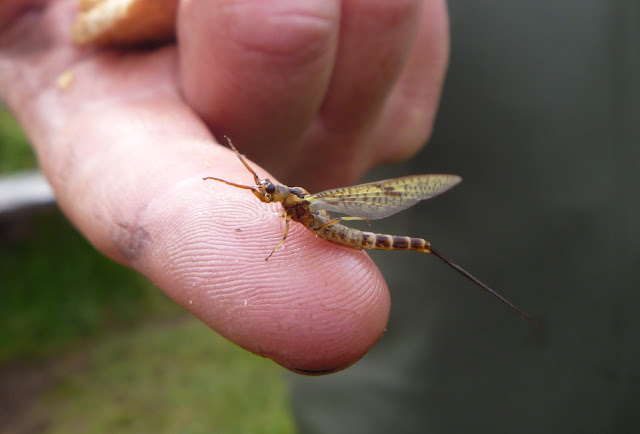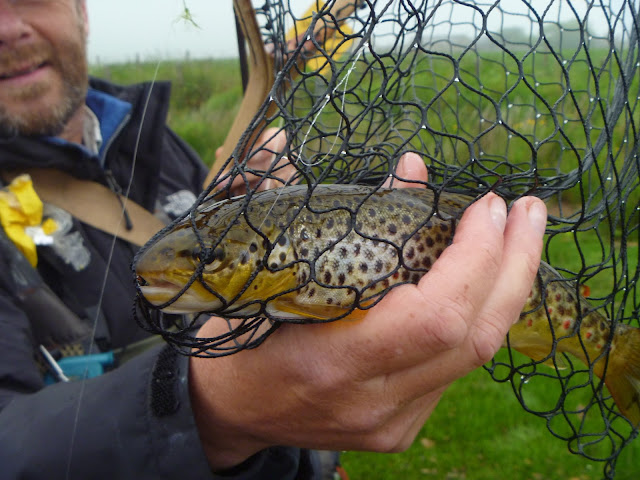 |
General
The warmer
weather in June at last resulted in more insect hatches, and much more evidence
of surface feeding fish, although regular rises tended to be fairly short and
sweet. Brown trout were generally looking up to feed, and could be attracted to
a dry fly even when not steadily rising.
Water
temperatures are still down a few degrees on the seasonal average, and with the
relatively dry month, water levels have now started to fall at most waters.
Fishing
Kennick –
Anglers continued to enjoy excellent sport during June, with more fish rising,
and floating lines with dry patterns becoming more and more successful. Fish
are now much more spread about the fishery, with boat anglers enjoying
particular success in Forest Bay and Clampitts Bay, and bank anglers catching
well all over. Popular dry patterns included Daddies, Black Gnats and Beetles,
with Hawthorns catching well toward the end of the month. Small sub-surface
nymph patterns have been the most successful (particularly Buzzers, Diawl Bachs,
Hare’s Ears, and Pheasant Tails) as well as the ever successful Damsel Nymphs.
Lures have taken the odd deeper fish (Nomads, Boobies, and Cats Whiskers), but
generally floating lines have proved to be the order of the day. The best fish
caught in June was a 6lb 1oz rainbow, caught by John Hern (from Exeter), using
an Orange Fritz from the bank during the Peninsula Classic competition at the
beginning of the month. A 5lb 6oz rainbow was caught by Mr. McCormack (from
Exmouth) as part of a full bag, using a Black Spider, and Mr. Davies (from
Kingsbridge) caught a bag of ten fish on catch and release, which included
rainbows of 5lb, 4lb, and 3lb 8oz.
Siblyback
- continued to fish well in June, with
anglers continuing to average over 3 fish per rod. Two Meadows and Small Marsh
carried on fishing well throughout the month, both from bank and boat, with
bank anglers also catching fish from the North Bank and Stocky Bay. Subsurface
nymph patterns (Damsels, Montanas, Diawl Bach and Buzzer) caught the most fish,
although as the month progressed more and more fish looked to the surface for
food, and a variety of dry patterns (including Hoppers, Bibios, Daddies,
Beetles, Black and Peacocks, and sedge patterns) started to catch fish. The
best fish of the month was a 4lb 5oz rainbow caught by Mr. T.Hunt using a Diawl
Bach.
Wimbleball
– The fishing became a bit more challenging in June, with the fish spreading
themselves around the lake, and many migrating to the Upton Arm area (mainly
accessible and fishable only by boat). Ruggs and Bessoms continued to prove
popular with bank anglers, and as the month progressed Black Buzzers proved
more and more popular, with the mornings producing the best fishing. Fish are
feeding on snails, and so a lot of fish are still down fairly deep. The best
fish of the month was an impressive 5lb 13oz rainbow caught by Rob Gale (from
Ashburton) while fishing from a boat. Stuart Gooding (from Barnstaple), while
attending a beginners’ course at Wimbleball, hooked and landed his first ever
trout – a 5lb 12oz rainbow. The fish was hooked less than 12 feet from the
bank, while hanging the fly (one of instructor John Dawson’s own patterns – the
‘Gale’) at the end of the retrieve. Peter Kempton (from Exeter) enjoyed a
superb day’s boat fishing, catching a full bag of fish that included rainbows
of 5lb 2oz and 4lb 10oz.
Stithians – Rod averages are now hovering
between 2 and 3 fish per rod, and with the slow start to the season, there are
now plenty of fish in the lake. Mornings and evenings are the best times to
fish, and bank fishing continues to be the most popular, although toward the
end of the month boat fishing produced some good sport. Yellowort and Chapel
Bays, Goonlaze Point, and Pub Bay are all fishing well, with fish taking a
variety of patterns, from Yellow Lures and Orange Fritz patterns, to Damsel
Nymphs and Montanas, and Hoppers and Sedges from the surface. As the conditions
continue to warm, prospects are good for top-of-the-water sport, particularly
in the evenings.
Fernworthy – small black patterns still continue to be the most successful flies (Montana Nymphs and small black Cats Whiskers); there are now a few Coch-y-bondhu beetles around and Fernworthy’s browns are starting to feed eagerly from the surface. Black Gnats, Ethafoam Beetles, and Hawthorn patterns are starting to catch well, and producing some exiting dry fly sport, particularly from the bank between the permit hut and the dam.
Fernworthy – small black patterns still continue to be the most successful flies (Montana Nymphs and small black Cats Whiskers); there are now a few Coch-y-bondhu beetles around and Fernworthy’s browns are starting to feed eagerly from the surface. Black Gnats, Ethafoam Beetles, and Hawthorn patterns are starting to catch well, and producing some exiting dry fly sport, particularly from the bank between the permit hut and the dam.
Burrator – the fish are now starting to look up for food, and are rising to large dark patterns (such as Sedges, Daddies, and Hoppers), although the majority of fish were caught on sub-surface nymphs (Diawl Bachs, Damsels, and Buzzers accounting for most). The South Bank and Longstone Peninsula proved to be the most productive areas. Peter MacConnell (from Plymouth) caught a 4lb 5oz rainbow (as part of a full bag), fishing from a boat using a Golden Olive Bumble. There is now a Wheelyboat and a rowing boat available at Burrator to provide boat fishing. These are available via the Burrator Fly Fishers Association, and must be booked in advance (see website for details).
Colliford – the warmer weather means that the brownies are looking to the surface to feed, with Brown and Black Hoppers, Hawthorns and Bibios, as well as pulled traditional wet patterns catching rising fish. Klinkhammers are catching fish feeding on emergers. It pays to fish the margins as well as the deeper water, stealthily keeping on the move to cover as much bank as possible.
Roadford – the fishing here just got better and better as the month progressed, particularly from the boats. Although there have not been many spectacular rises, the fish have been feeding eagerly, with leeches and tadpole patterns proving to be particularly successful, and a lot of good sized fish accumulating around the ‘boils’. Andy Birkett (from Plymouth) caught browns of 6lb, 4½lb, and several fish between 2 and 3½lb. Bernie Maher (from Derby) caught a 5lb 6oz brown from the bank. Local angler, Wes Ower (from Broadwoodwidger) had three successful trips out with different boat partners, catching some quality fish on each session from the ‘boils’ using leach and tadpole patterns: with Mike Parkyn (from Cornwall),21 fish up to 4½lb; with Graham Angel, 14 fish to 4lb; and 16 fish up to 4½lb on the third session.










